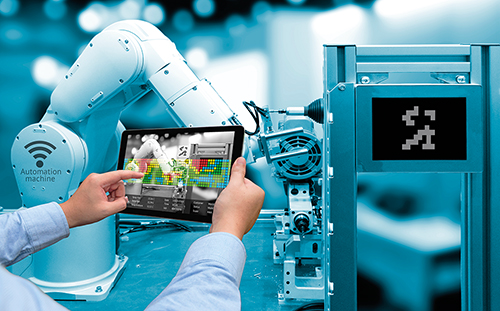Electro Optics turns 50 in 2018. To mark the occasion, experts across industry and academia review the current state of the photonics industry and highlight what needs to happen for the field to prosper over the next five decades.
Dr Wenko Süptitz, head of photonics at German industry association, Spectaris, discusses Industry 4.0 and how far advanced German and European companies are with implementing digital production processes
How do you define internet of things?
For us, we’re focused on the industrial internet of things (IoT). Although we do look at applications like sensors in smart phones, for example, as an industry association, the companies we represent are more involved in the production equipment of smart phones, not in the production of smart phones themselves (which tends to happen in Asia).
There are three areas where we see photonics contributing to Industry 4.0 or IoT – optical sensors, human-machine interaces, and additive manufacturing. Sensors are required to get the data into the digital world, and actuators to get the digital processing back into a physical motion. Also, photonics will be essential for enabling the human-machine interaction – how robots interact with each other, with people and how they move in their 3D environment.
Lasers are very well suited to processing materials according to a digital blueprint, which works better than the traditional machines. Many laser processing applications – like cutting, welding, marking, and more recently laser additive manufacturing – are all driven by digital input.
How can companies collaborate to enable these IoT concepts?
In Germany we have strong government support for these concepts. We have platforms for Industry 4.0, and there are several regional clusters that hold regular workshops. There are also testbeds that photonic companies are involved in.
These activities provide good opportunities for networking and collaboration between SMEs and larger companies such as Siemens or Trumpf. We see that networking and collaboration is strong in Germany, and Europe in general, which gives us an advantage. It also provides an opportunity for solving complex issues surrounding digitisation that may not be the focus point of Google and other large software firms, which seek applications that are similar everywhere in the world. But for applications involving a large extent hardware, European companies can really benefit from the strong networks we have across Europe.
What is Spectaris doing to help advance Industry 4.0 in Europe?
We organise annual meetings and conferences – for example we’ve organised a series of conferences, called Photonik 4.0, which in 2016 had a focus on production technology, and in 2017 on medical applications.
After these conferences, we bring together what was discussed during the presentations, round-table discussions, and workshops. If possible, we also ask all of the participants to give their personal opinion. We then collate all of this in a white paper aimed at the German government.
On a regular basis, we put forward industry needs and interests, and emphasise the special interests of photonics to the German Federal Ministry of Economy so that these points are included in their large strategic roadmaps.

How far advanced is Industry 4.0?
I think the technical groundwork is already pretty far advanced. The other element is to look at how far ahead companies are with the implementation of these concepts in routine production in Germany, in Europe, or all over the world. And there we see a gap. From our experience most companies do not immediately jump on these new concepts [of Industry 4.0] – there needs to be a certain market pressure in order for them to do so.
Companies will first try to optimise existing procedures that they’ve been used to for many years before they start to implement Industry 4.0 processes. So, there is a time delay. However, we are noticing that more and more companies are starting to realise that implementing Industry 4.0 equipment and procedures is a must to survive in the future.
There is a gap between the technology, what is possible in principle, and what is found on production floors today.
How have SMEs adopted Industry 4.0 practices compared to large companies?
I think large companies can afford to dedicate a reasonable amount of money to new production concepts. It’s much more difficult for smaller ones – they find the concepts interesting, but only see them as an option for larger firms because they cannot make that level of investment.
With SMEs, to a certain extent, it also depends on the owner and what kind of vision they have for the company over the next 10 to 20 years.
There are a few advanced companies who have been early adopters. Other firms hesitate because they will look at their estimated revenues for the next few years, and if the figures are already healthy, then they will be reluctant to invest in new technology when it is not clear how quickly – and to what extent – it will increase profits.
What needs to happen to advance the concept of Industry 4.0?
Of course standardisation is important for diffusing uncertainty among companies when they are deciding if it’s time to invest in these technologies or not. As long as many things are still experimental and it’s not clear what the regulations or the standards are, then many companies will continue to hesitate to invest.
In Germany, I would add that it’s very important – especially for SMEs – for areas outside of cities to get faster internet, so that companies in these locations can reap the full benefits of having a highly interconnected production environment. At the moment this is still an obstacle for many SMEs. We hope that the new government will put more attention and money into it.


